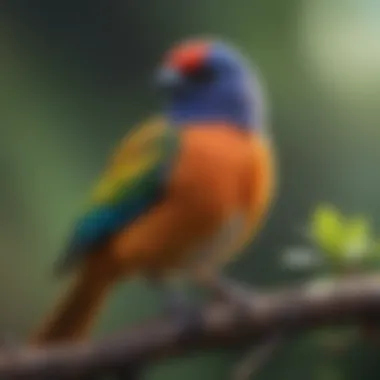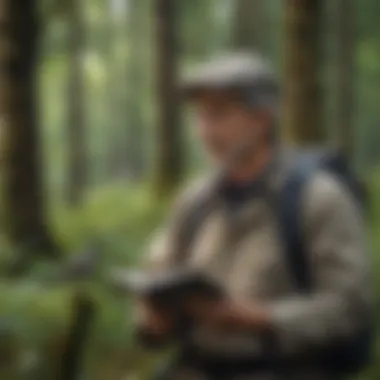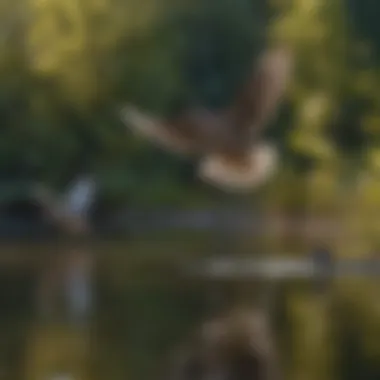Recognizing Birds: Techniques for Identification


Intro
Birds grace our skies with their varied colors and unique calls, standing as a testament to the diversity of nature. For many, recognizing birds becomes more than just a pastime; it's an enriching journey into their lives. Understanding how to identify different species not only opens the door to appreciation but also fosters a deeper connection to our ecosystems.
Avian identification can seem like a daunting task, especially with thousands of species flitting about. However, whether you are a rookie equipped with just binoculars or a seasoned birdwatcher who can distinguish a warbler from a wren, there is always something new to learn. From gaining familiarity with habitats to recognizing calls, every detail matters in this intricate puzzle of nature. This exploration will guide readers through avenues of observation, practical techniques, and modern technology that can illuminate the hidden world of birds.
Birdwatching isn’t solely about identifying feathered friends; it’s also about fostering an emotional attachment to the fauna that share our space. Thus, the adventure entails engaging with local ecosystems and developing a personal bond with the avian world. This guide covers techniques, tools, and insightful advice, ensuring you embark on a rewarding birdwatching experience.
The Significance of Bird Recognition
Understanding birds is not just about appreciating their beauty; it's a multifaceted journey that brings significant rewards. Recognizing birds lays the groundwork for a greater connection between humans and nature. This connection is vital for several reasons, particularly in terms of environmental awareness, conservation efforts, and an enhanced appreciation for biodiversity.
Understanding Avian Diversity
Birds are an incredibly diverse group of animals, with around 10,000 species distributed across different habitats around the globe. Each type of bird plays a unique role in its ecosystem. Take the common blue tit, for instance. It’s not just a pretty face; its foraging habits help control insect populations, providing a balance that supports plant life. By learning to identify such species, birdwatchers contribute to a more comprehensive understanding of local ecosystems.
When you recognize birds, you start to see the relationships they have with their environment and one another. Different species may hold unique significance in cultural traditions or may indicate specific environmental conditions. Knowledge of avian diversity not only enriches your experiences in nature but helps in recognizing ecological changes that may go unnoticed otherwise.
The Role of Bird Recognition in Conservation
Bird recognition can act as a powerful tool in conservation. Identifying species that are struggling to survive can lead to immediate action when addressing habitat destruction, climate change, or other threats. For example, if birdwatchers notice a decline in the local population of sparrows, they can raise awareness among community members and lead initiatives to protect their habitats.
Moreover, many communities engage in citizen science projects, where bird enthusiasts collect invaluable data through organized monitoring and tracking of bird populations. This kind of grassroots involvement has practical implications for conservation efforts, guiding policies and funding.
"Every time you identify a bird, you're not just confirming its presence—you're contributing to the larger conversation around conservation and ecological stability."
In essence, bird recognition translates into action. By fostering an understanding of the vital roles that birds play in ecosystems, you equip yourself and others to raise the flag in defense of their habitats. It's not just a leisure activity; it's a call to be vigilant advocates for our winged companions and their environments.
Physical Characteristics as Identifiers
Birds, with their vibrant plumage and diverse forms, offer a fascinating subject for identification. Understanding the physical characteristics of birds is crucial for toggling the complexities of avian recognition. These physical traits often serve as the primary identifiers in distinguishing between species, making them an indispensable tool for birdwatchers of every skill level.
When you take a closer look at a bird in your backyard or while on an adventurous hike, consider the richness of information available through its appearance. Each feather, every curve, and specific anatomical feature contributes to not only its beauty but also its identity. Recognizing these traits helps build a solid foundation for your understanding and connection with the avian world.
Recognizing Plumage Patterns
Plumage really is the crowning glory of birds. The patterns and colors of feathers can vary dramatically from one species to another. For example, the spotted coat of a juvenile American Robin contrasts with the more uniform, rich hues of an adult. When observing any bird, take note of color variations, spots, and stripes, as they can provide major clues for identification.
Some birds exhibit seasonal changes in their plumage. For instance, the male Northern Cardinal sports a vibrant red in breeding season but may appear somewhat duller outside of this period. Thus, understanding when to observe these changes can be just as important as recognizing the shapes of birds themselves. Remember, the art of identifying birds also involves looking beyond what meets the eye.
Size and Shape Considerations
Size and shape are critical in identifying birds. Many enthusiasts find comparison to household pets helpful; recognizing that an American Crow is about the size of a small cat can offer a more relatable perspective. Shape plays a pivotal role as well. The long, slender body of a heron is a stark contrast to the plump, round build of a sparrow.
Consider a few questions when assessing size and shape:
- What’s the relative size of the bird compared to other species?
- Are the wings larger than expected for its body?
- Does the bird have a unique structure, like a long tail or a curved neck?
Analyzing these aspects not only helps with identification but also elevates your overall birdwatching experience.
Beak and Leg Variations
The beak and leg variations of birds serve a more than aesthetic purpose; they reflect a bird's diet and behavior. Take the enormous, stout beak of a toucan, adapted for cracking nuts and fruits, compared to the slender, sharp beak of a hummingbird designed for sipping nectar. What that tells you is how well-adapted each bird is to its environment and habits.
Similarly, leg variations can signal things about where birds spend their time. Long legs are indicative of wading birds, like herons, that frequent shallow waters. In contrast, smaller, sturdier legs belong to birds that spend most of their time hopping on branches or the ground.
In essence, understanding the physical characteristics of birds is not just about capturing their beauty; it’s about uncovering the myriad ways they interact with their environment.
Recognizing these identifiers enhances your understanding and appreciation of the avian world. Just as one might appreciate the artworks of renowned painters, identifying birds through their physical traits can lead to a fulfilling journey of discovery.
Behavioral Cues to Identification


When it comes to recognizing birds, behavioral cues offer a treasure trove of information. While physical characteristics like plumage and size are essential, the behaviors exhibited by avian species can reveal their identity just as effectively, if not more so. This section focuses on the importance of understanding these behaviors and how they assist in identifying different species.
Flight Patterns and Calls
Birds possess unique flight patterns that can act as an instant identifier in the field. Some species, like the American Robin, display a distinctive flapping style, perhaps more direct and consistent than that of the Barn Swallow, which is known for its acrobatic maneuvers and swift changes in direction.
In the same vein, bird calls serve as auditory fingerprints. The melodious whistle of a Common Loon is unmistakably different from the sharp ‘chick-a-dee-dee-dee’ of the Black-capped Chickadee. Getting attuned to these sounds might require patience, but it offers a rewarding insight into the avian world.
"A bird in the bush is worth two in the hand." – This old saying can easily relate to the notion that understanding one bird often leads to recognizing another, especially in flight or during vocalizations.
Feeding and Social Behaviors
How birds feed and interact with one another is also telling. Take the example of Woodpeckers, which usually drill into trees in search of insects. Their technique involves rhythmic pecking and can tell you much about their species. In contrast, the Goldfinch prefers to forage on thistle seeds, often seen hanging precariously from the stem while they feed.
In terms of social behavior, flocks of birds exhibit different dynamics. Starlings, for instance, are known for their synchrony, creating mesmerizing murmurations that are both breathtaking and indicative of their species. Meanwhile, sparrows may gather in smaller, more casual groups. Observing these social structures will help you not only recognize specific birds but start to notice when they feel threatened or comfortable in their habitat as well.
Nest Building and Rearing Practices
The ways in which birds construct their nests can vary immensely. The Bald Eagle builds massive nests often reused year after year, while the House Sparrow opts for smaller, less structured installations, regularly abandoned and rebuilt anew. Birds like the Red-winged Blackbird construct nests in dense reed beds, a clever tactic to stave off predators.
Raising young is another critical behavior for identification. Some species, such as the Eastern Bluebird, display cooperative breeding where multiple birds may help feed the young. Others like the American Goldfinch prefer solitary parenting, showcasing behaviors that can provide clues about their identity.
In summary, understanding behavioral cues adds a rich layer to identifying birds. From flight patterns and calls to feeding habits and nesting practices, observing avian behavior prompts deeper insights that go beyond mere appearance. With practice and patience, learners can begin to distinguish among species simply by watching and listening.
As you venture into the fascinating world of birds, pay attention to these behaviors—they form the canvas upon which the details of each species reveal themselves.
Utilizing Technology for Identification
In today's fast-paced world, technology has become an essential ally for bird enthusiasts. The ability to use various tools not only streamlines identification processes but also enhances the overall experience of birdwatching. Utilizing technology for bird identification is akin to having a seasoned guide in your pocket. It opens up a wealth of information and resources that were once hard to come by. Modern tools help in observing, capturing, and sharing avian encounters, allowing both casual observers and serious enthusiasts to explore the rich tapestry of avian life.
Mobile Applications and Identification Tools
Mobile applications have changed the game when it comes to identifying birds. These tools allow users to access comprehensive databases of bird species at their fingertips. One of the leading examples is Merlin Bird ID, which offers a bird identification guide based on user inputs, such as location and characteristics of the bird witnessed. Users can submit photos or answer questions about plumage, size, and behavior to receive suggested matches. Another popular option is iNaturalist, which encourages community participation. Users can upload their findings and receive feedback from experts and fellow birders alike.
- Immediate Access: With a smartphone at hand, birdwatchers can instantly look up information, eliminating the need to carry bulky field guides.
- User-Friendly Interfaces: Many apps include features like sounds and visual aids to help in quick recognition.
- Location-Based Suggestions: Certain apps tailor suggestions based on geographical location, making it easier to identify region-specific birds.
Online Databases and Communities
Online databases serve as a treasure trove of information for bird identification. Websites such as Cornell Lab of Ornithology and eBird compile vast amounts of data on bird sightings, behaviors, and habitats. This data can empower bird watchers to connect sightings with scientific research. By participating in these platforms, individuals not only learn about their avian neighbors but also contribute to global birdwatching and conservation efforts.
- Interactive Maps: Many databases allow users to observe migration patterns or search for specific species in their area.
- Community Engagement: Forums and discussion boards can help enthusiasts share experiences, tips, and even personal photography.
- Citizen Science: A wealth of knowledge is generated when everyday birders contribute data on bird sightings, helping to track populations and movements.
The Role of Social Media in Avian Discovery
Social media platforms like Facebook, Twitter, and Instagram have become vibrant communities for birdwatchers. Enthusiasts share photos, experiences, and identification tips that not only inspire others but also create a network of support and knowledge.
Social media is particularly powerful because:
- Visual Storytelling: Platforms such as Instagram allow birders to showcase their encounters in a visually compelling way, making identification popular and engaging.
- Real-Time Updates: Groups often post about rare sightings or share immediate tactics for identification, keeping everyone in the loop.
- Networking: Making connections with local and expert birders can lead to guided experiences and tips that are invaluable for beginners.
"By utilizing technology, birdwatchers can not only enhance their observation skills, but they also become part of a larger community that celebrates the wonders of the avian world."
In short, merging tradition with technology not only enriches personal knowledge but strengthens a community committed to furthering conservation and appreciation efforts. With tools and resources at their disposable, bird lovers of all levels can deepen their understanding and connection to the richly diverse world of birds.
The Importance of Habitat in Bird Recognition
Understanding the habitat of various avian species is like putting on a pair of custom-fit glasses—everything comes into focus in a more vivid way. Habitat influences not only the presence and identification of birds but also their behaviors, breeding patterns, and feeding habits. Recognizing the environment in which a bird thrives serves as a vital tool in the identification process. When you think about it, birds are often shaped by their surroundings. A bird's plumage, for instance, can reflect the colors of its habitat, aiding in camouflage or helping with mating displays.
Some essential considerations about habitat in bird recognition include the type of ecosystem, climate conditions, and human impact on these environments. Local ecosystems provide specific resources that birds rely on for survival, like food, shelter, and nesting sites. The diversity of bird species often correlates directly with the richness of their ecosystems. This means certain locales will offer you a prominent chance to spot distinct birds—natural goldmines for birdwatchers.
Local Ecosystems and Bird Species


Each local ecosystem—be it wetlands, forests, deserts, or urban areas—hosts unique bird species that are specially adapted to live there. For instance, in wetlands, you might find herons and ducks, both of which are skilled at navigating through water, while in dense forests, vibrant warblers flit about among the branches. Not only does each ecosystem support different species, but it can also dictate the abundance of birds, varying from one season to another.
Identifying Key Features of Local Ecosystems:
- Vegetation Type: Different types of trees, shrubs, and grasses harbor specific species. For example, coniferous forests are often home to crossbills, while deciduous forests attract a wide array of owls and sparrows.
- Water Sources: Rivers, lakes, and even puddles can attract unique birds. Waterbirds like egrets and ospreys are particularly keen on such habitats.
- Microhabitats: Look out for edges between habitats, as these are often hotspots for diverse bird activity. For example, the intersection of a forest and a field provides resources for many birds, creating an environment teeming with life.
By tailoring your observation strategies to specific local ecosystems, you gain a comprehensive approach to birdwatching, enhancing both identification skills and ecological awareness.
Seasonal Changes and Migration Patterns
As seasons change, so do the birds that inhabit your region. Many species migrate to take advantage of seasonal resources, altering the landscape of birdwatching opportunities. Migration patterns can illuminate the timing and frequency of bird appearances, highlighting how habitat influences mobility among avian populations. Some birds, like the American Robin, may show up in your backyard in early spring, only to fly south at the first hint of frost.
Factors Influencing Migration:
- Temperature Fluctuations: Warmer climates often attract more birds, pushing them to migrate sooner or travel farther.
- Food Availability: Changes in plant and insect food sources dictated by the seasons can impact when birds migrate.
- Breeding Grounds: Opting for specific habitats as breeding sites may draw birds to certain areas during the spring and summer months.
By understanding these seasonal changes, birdwatchers can be more strategic in their identification efforts, scheduling outings during peak migration periods to spot rare avian visitors. Whether it’s the vibrant flashes of migrating warblers or the striking silhouettes of raptors soaring above, the interplay between habitat and seasonal dynamics creates a rich tapestry of opportunities for bird enthusiasts.
"Observing bird patterns over time can lead to a deeper connection with nature, and eventually, that shared rhythm of life becomes unmistakably apparent."
Developing an Eye for Detail
Birdwatching is more than just spotting a feathered friend; it’s about developing an eye for detail that allows you to truly appreciate the diversity and beauty of avian life. By honing in on the subtleties of shape, color, and behavior, enthusiasts can elevate their identification skills from simply recognizing a bird to truly understanding its place within the ecosystem.
Being skilled at observation not only enhances your ability to identify different species but also deepens the connection you share with nature. Recognizing birds becomes a multifaceted experience where you can appreciate their uniqueness and the roles they play in their respective habitats.
Here’s what to consider when developing your observational skills:
- Patience: Good observation takes time. Birds can be shy, and often the best views come when you are quietly still. Waiting in silence can yield unexpected and delightful sights.
- Familiarity: Knowing what birds are common in your area can help you spot the unusual. This enables you to develop a mental catalog of local species.
- Mindfulness: Stay aware of your surroundings. Birds are quick; a moment of inattention can mean missing the best part of their activity.
- Practice: The more you observe, the better you become. Accentuating details grows from regular practice across different locations and conditions.
The Art of Observation: Skills and Techniques
Observing birds effectively involves more than just looking; it's a blend of several vital skills and techniques. Here are key aspects to keep in mind:
- Binocular Use: High-quality binoculars are your best friend. They enable you to see distant birds clearly without disturbing them. A good pair can make a world of difference.
- Field Notes: Keeping a field journal can greatly enhance your observational skills. Note down color patterns, behaviors, and even the sounds made by birds you identify.
- Bird Calls: Learn to recognize calls and songs. It’s often easier to spot a bird by its call than by sight alone. A simple app can help you familiarize yourself with the sounds of local species.
Daily practice of these techniques can turn you into an observant birder.
Photography as a Tool for Identification
In this digital age, photography serves as a powerful tool for bird identification. Not only does it allow for visual documentation, but it also enhances your ability to notice details that the naked eye might miss.
Here’s how photography assists in birdwatching:
- A Record of Sightings: Snapshots provide a tangible record of your sightings, which can be referenced later for identification.
- Detail Observation: When reviewing photos, you can analyze colors, plumage patterns, beak shapes, and other characteristics more closely.
- Sharing Knowledge: Posting photos online, in communities like subreddit r/Birding or platforms like Facebook can lead to insights from other bird enthusiasts. They can help you identify species or point out characteristics you may have missed.
Overall, using photography in tandem with traditional observational skills enhances the enjoyment and accuracy of birdwatching. With practice, you'll find your ability to identify birds becoming sharper, creating a richer outdoor experience.
Expanding Your Knowledge Base
In the realm of bird identification, expanding your knowledge base goes beyond the mere identification of species. It’s about understanding the intricate web of interactions in the avian world and gaining a deeper appreciation for the environment. This enhancement is crucial not only for enthusiasts but also for the conservation of diverse species and habitats.
The benefits of broadening your knowledge are multifaceted. Firstly, comprehensive understanding equips birdwatchers to identify species more accurately and swiftly. The more one knows about the variations in plumage, behavior, and habitats, the less likely they are to fall into common traps of misidentification. Additionally, this knowledge fosters a greater connection to nature—transforming casual observations into deep, meaningful experiences.
Moreover, there's a world of information available, making it easier than ever to satisfy your curiosity. Understanding the local fauna, seasonal patterns, and behavioral nuances can significantly enhance your birdwatching weekends.
Books and Field Guides
Books and field guides are the cornerstones of birdwatching literature, serving as indispensable tools for both newbies and seasoned watchers alike. These resources not only provide detailed illustrations and descriptions of bird species, but they also delve into aspects like migration habits, feeding behaviors, and song patterns.
A well-chosen field guide can be your reliable companion. It should feature:


- Colorful, accurate depictions of birds to aid in visual identification.
- Comprehensive information on the habitats where birds are commonly found.
- Tips for recognizing subtle differences between similar species.
For example, Roger Tory Peterson’s Field Guide to the Birds stands out as a favorite among many birders. It introduces unique identification techniques, emphasizing the importance of observing markings and behaviors distinct to various species. Field guides can also spark interest in learning more about birds that inhabit your local area, offering insights into their migration seasons or nesting habits.
Workshops and Birding Tours
Engaging in workshops and birding tours provides a hands-on approach to learning that books alone may not suffice. These experiences immerse you in environments filled with birds, allowing you to apply your theoretical knowledge in practical situations. Guided tours often offer the expertise of seasoned birders, who can share invaluable tips and techniques that simply can't be learned from a book.
Participating in workshops, especially those that focus on specific techniques like bird calls or photography, can enhance your skills significantly. Workshops often cover important topics such as:
- Identifying vocalizations of different species: Understanding bird calls can help you locate birds without relying solely on sight.
- Using equipment effectively: Learning how to use binoculars or spotting scopes can drastically improve your observation skills.
- Field identification tactics: Hands-on practice helps solidify knowledge of important identifying features in varied conditions.
By participating in birding tours, you not only gain firsthand experiences observing birds in natural habitats but you also connect with other birding enthusiasts. This community engagement fosters a supportive environment where knowledge can be shared.
"The more you learn about birds, the more you realize how wonderful and complex their lives are. It feels like uncovering a hidden world right in your own backyard."
Connecting with the Avian Community
Developing a strong connection with the avian community is more than just a hobby; it’s a vital aspect of bird recognition that enriches your understanding and appreciation of these creatures. Engaging with fellow bird enthusiasts opens doors to shared experiences, knowledge exchange, and collective conservation efforts. It’s about building friendships while fostering a deeper connection to nature. Through these relationships, individuals can learn unique identification techniques that aren’t often found in books or online resources.
Being part of a community can also provide support and encouragement. Many newcomers to birdwatching feel hesitant about their knowledge or identification skills. However, local groups often have members willing to guide and share insights. This camaraderie can motivate individuals to go out and explore the natural world with confidence. Think of it as stepping into a circle where everyone shares a common interest and passion.
"Birding is not just about seeing, it’s about sharing experiences with those who appreciate the beauty of flight."
Local Birdwatching Clubs and Organizations
Local birdwatching clubs serve as hubs for individuals interested in birds and their habitats. Joining one provides numerous benefits, from organized outings to educational programs. Most clubs have a calendar packed with activities, including bird counts, guided walks, and workshops tailored to enhancing identification skills.
Benefits of Local Birdwatching Clubs:
- Networking: Meeting folks passionate about birds leads to lifelong friendships.
- Learning Opportunities: Regular workshops increase your bird identification acumen.
- Field Trips: Clubs often organize trips to different habitats, exposing you to diverse species and behaviors.
- Community Engagement: Participate in conservation efforts while connecting with local ecosystems.
These clubs foster an environment where one can ask questions and learn at their own pace. New members often bring fresh perspectives and curiosity; this can lead to spirited discussions about various bird species.
Volunteering for Bird Conservation Projects
Volunteering for bird conservation projects is another way to immerse oneself in the avian community while making a tangible impact. Engaging in these initiatives not only aids in the protection of local bird populations but also enhances one’s understanding of their roles in the ecosystem. Such experiences can deepen your appreciation for birds beyond mere identification.
Considerations for Volunteering in Bird Conservation:
- Hands-On Experience: Participating in activities like habitat restoration can provide insight into the environmental challenges birds face.
- Learn from Experts: You can gain knowledge directly from biologists and conservationists who often lead these projects.
- Connect with Like-Minded Individuals: Working alongside others passionate about conservation fosters deeper relationships.
- Make a Difference: Your efforts can significantly contribute to the preservation of endangered bird species.
Whether it’s through local clubs or conservation projects, connecting with the avian community creates a rich tapestry of interactions that enhance both personal knowledge and collective action. Engaging with others not only enriches your own birdwatching experiences but also fosters a sense of responsibility towards protecting and respecting our feathered friends.
Ending: Embracing Avian Recognition
Understanding and embracing the journey of bird recognition is not merely a hobby; it's a profound commitment to appreciating the beauty and complexity of the avian world. This article has traversed multiple facets of identification, emphasizing both the techniques and the emotional connections that come with observing these remarkable creatures.
At its core, the significance of bird recognition lies in fostering a deeper relationship with nature. When individuals invest time in identifying different species, they often find themselves more attuned to their environment. Not only does this enhance personal enjoyment, but it also cultivates a sense of stewardship towards local ecosystems. The process encourages awareness about conservation efforts, reminding everyone of their role in preserving habitats that are vital to birds and other wildlife.
The Lifelong Journey of Bird Appreciation
Birdwatching is a venture that knows no expiration date. For many, it starts with an innocent curiosity, perhaps sparked by a vibrant flash of color or a melodious song. As one delves deeper, this journey transforms into a lifelong passion. Every bird sighting can unveil new insights, and each encounter tells a story worth remembering.
Participants often find themselves sharing their experiences, connecting with others who share their enthusiasm. This community aspect turns individual exploration into collective celebration.
From the thrill of spotting a rare species to the simple joy of witnessing common backyard birds, each experience adds layers to appreciation. Books, field guides, and even social media platforms like Reddit enable enthusiasts to share findings and broaden their understanding, making the journey not just personal but communal.
Encouragement to Explore Further
In the spirit of continuing this exploration, it’s crucial not to forget the wealth of resources available. This includes local birdwatching clubs, where individuals can find mentorship and guidance. Workshops provide hands-on experiences that take theoretical knowledge into practical learning.
Feeling ambitious? Consider birding tours that transport you to prime habitats, enriching your understanding of diverse avian populations. Furthermore, local ecosystems offer unique opportunities for close observation, as shifts throughout the seasons present new birds and behaviors.
As you continue on this path, remember that each bird observed is a window into the larger mysteries of the planet. Don’t shy away from asking questions or seeking out more information. For instance, dedicated platforms such as Wikipedia and Britannica present vast amounts of data about various species, their behaviors, and habitats.
As the world of birds unfolds before you, the encouragement to explore further remains as vital as the first spark that ignited your interest. Embrace the complexities, take joy in the simple observations, and, most importantly, let your appreciation for these feathered creatures grow ever deeper.















